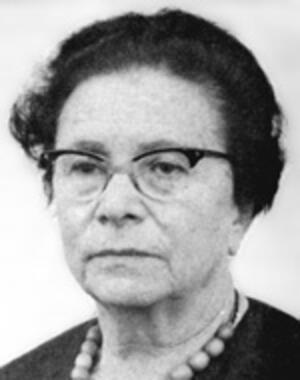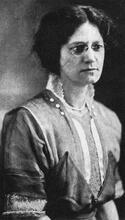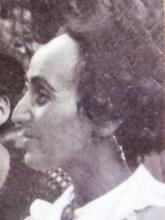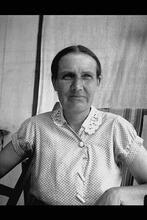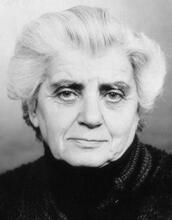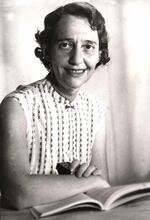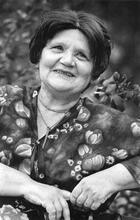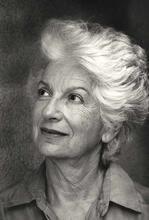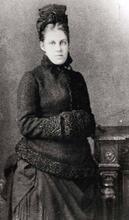Anda Pinkerfeld Amir
Anda Pinkerfeld Amir helped shape Hebrew literature as both an innovative, modernist Israeli poet and as a writer of children’s books that addressed difficult subjects such as war and death. A member of the Zionist group Ha-Shomer ha-Za’ir, Amir tried to make Aliyah in 1920, returned home to Poland, then married and made a successful second attempt with her husband in 1924. She published her first volume of Hebrew poems in 1929, later working in Displaced Persons camps in Germany. She was one of the few Israeli poets, male or female, to discuss the Holocaust. Amir’s work has garnered critical success and inspired generations of readers.
“I am like all women:/belonging/I am like all women:/devoted. But in the corner of my lips a strange expression lies in wait/ in the corner of my eye a strange spark flashes./Many times I’ll bend my head/I, who belong, even to the smallest of my lovers./But suddenly, with the tuning of spring/I’ll shun you all/and straighten up./Hey you! Know this well!/I’ve never belonged to you/Not to any of you!/A free woman I’ve been/and always shall be!” (Yuval, 1932).
So begins one of Anda Pinkerfeld-Amir’s best known and most iconoclastic poems, representative of both her modernist form and her feminist content. While earlier critics of her verse tended to dwell on the first “womanly” lines of the poem, viewing her work as the “poetry of the devoted, belonging woman,” (Benzion Benshalom in Anda: Kovez Ma’amarim, 14), a newer generation of readers has highlighted the more subversive and formally innovative aspects of her poetry.
Zionist Roots
Anda Pinkerfeld was born in Rzeszow, Poland, on June 26, 1902. Her father Joel Pinkerfeld, who served as an officer in the Polish army, was an architect who designed buildings in Galicia. Her family was assimilated and cultured; as anti-Zionists, they did not believe in the necessity of Hebrew or Jewish education. Anda wrote her first work in Polish, a prayer for the emancipation of Poland, when she was seven years old and published her first volume of Polish poetry (Pie’sni Zycia, Song of Life, 1921) when she was eighteen. In the wake of antisemitic pogroms in Lvov, Anda came under the sway of Ha-Shomer ha-Za’ir while a student at a Polish gymnasia and switched schools to the Jewish gymnasia in Lvov. A committed Zionist, Anda immigrated with Ha-Shomer ha-Za’ir to Palestine in May 1920, but due to a heart ailment returned to Lvov, where she earned a bachelor’s degree. In 1924 she returned to Palestine, this time with her husband, the agriculturalist A. Krampner-Amir. After living in Bet Alfa and Tel Aviv they eventually settled in Kiryat Anavim and had a daughter named Zippor. Later, they moved to Tel Aviv where they had a son, Amos, who eventually served as a pilot in the Israel Air Force. In the aftermath of World War II, Pinkerfeld-Amir went to work in the Displaced Persons camps in Germany under the auspices of the Jewish Agency. Throughout her year and a half in Europe, Pinkerfeld-Amir kept a diary of her experiences, a literary/historical testimony, which is housed in Beit Levin Kipnis/Seminar Levinsky as part of a collection of her manuscripts. She later worked in the archives of the Ministry of Defense, assembling records of the Israeli soldiers who fell in the 1948 War of Independence.
Under the influence of the poet Uri Zevi Greenberg, Anda Pinkerfeld Amir abandoned her ambitions to be a Polish poet and undertook to write Hebrew verse. Her first Hebrew poem was published under the matronym “Bat-Hedvah,” Hedvah being a Hebraized form of her mother’s nickname “Freude” (Yaoz-Kest in Anda: Kovez Ma’amarim, 132). Upon publishing Yamim Dovevim (Whispering Days, 1929), her first volume of Hebrew verse, Anda reverted to writing under her own name.
Pinkerfeld-Amir’s early Hebrew poetry consisted mainly of short lyrics, written in free verse form. The poet Rahel wrote an admiring review of her first book, noting the spare, modernist clarity of her poetry, its confident indifference to the conventions of rhyme, meter and stanzaic form, and the lively elasticity of the language (See Anda: Kovez Ma’amarim, 9–10). Other critics such as Jacob Fichman (1881–1958) and Benzion Katz (Benshalom, 1907–1968) offered more tepid praise, taking issue with the unrestrained prosaic quality of her verse (Anda, Kovez Ma’amarim, 12, 14). More recently critics such as Ittamar Yaoz Kest and Michael Gluzman have endeavored to bring to light Pinkerfeld’s role as one of Hebrew poetry’s first modernist innovators. (Yaoz-Kest in Anda: Kovez Ma’amarim, 132; Gluzman, 130–136).
Judaism and Literature
Particularly noteworthy are Pinkerfeld-Amir’s reworkings of the stories of biblical men and women. Jubal, Esau, Avishag, Eve, Hagar, Jephthah’s Daughter, Lot’s Wife, Delilah, Jael—all of these figures, rarely venerated or accorded attention by traditional (male) writers, are revisioned in Pinkerfeld-Amir’s poetic A type of non-halakhic literary activitiy of the Rabbis for interpreting non-legal material according to special principles of interpretation (hermeneutical rules).midrashim . In her portrait of Eve, for example, the biblical first woman never eats the fruit of the Tree of Knowledge; instead, she studies it and thus awakens into an awareness of her own fecundity and creativity. In other poems, such as her portrait of Lot’s wife, Pinkerfeld-Amir gives voice to figures silenced and/or marginalized by the collective tradition. “Drunk on yesterdays am I,” says Pinkerfeld-Amir’s Lot’s wife. “How can I not look backwards?”
The events of World War II and the 1948 War of Independence effected a major change in Amir-Pinkerfeld’s poetry. As Yohai Oppenheimer has noted, if her earlier poems about biblical figures evince a note of (feminist) protest against the national/religious values of the Bible (and by implication, the emerging Jewish state), her poetry in the 1940s and 1950s conformed in style and substance to the national ethos. This poetic transformation is best exemplified by her long epic poem Ahat (1952), which dramatizes the story of Rachel Seltzer, a Holocaust survivor who died tragically while serving as a soldier in the 1948 War of Independence. In taking on this epic voice Amir-Pinkfeld distinguished herself from female contemporaries such as Rahel and Esther Raab, who mainly employed the personal, lyric form. In her willingness to tackle the subject of the Holocaust Pinkerfeld-Amir was anomalous not only among female but also among male Israeli writers of the 1948 era, who deliberately avoided this difficult material. In her last two collections, Tehiyyot (1976) and U-vekhol Zot (1980), Pinkerfeld-Amir returned, in a certain sense, to her lyric beginnings, but at the same time retained some of her epic and communal concerns.
Anda Pinkerfeld-Amir is best remembered in Israel as a children’s writer. In such collections as Kokhavim ba-Deli (Stars in the Bucket, 1957) and Shalom, Yeladim she created whimsical, playful rhyming works: poems such as “Ha-Gedi shel ha- The "guide" to the Passover seder containing the Biblical and Talmudic texts read at the seder, as well as its traditional regimen of ritual performances.Haggadah,” in which the speaker announces her plan to hide the kid of Had Gadya before A seven-day festival to commemorate the Exodus from Egypt (eight days outside Israel) beginning on the 15th day of the Hebrew month of Nissan. Also called the "Festival of Mazzot"; the "Festival of Spring"; Pesah.Passover, or “Shetei Ahayot” (Two Sisters), which tells of two rhyme “sisters,” mitriyyah (umbrella) and pitriyyah (mushroom), who suddenly meet and discover all that they have in common. In other more serious works for young readers, such as Sod im Ahi ha-Gadol (A Secret with My Older Brother), Pinkerfeld-Amir attempted to help children cope with the tragic loss of family members killed in the various Israeli wars. Several of her children’s books were illustrated by renowned artist Nahum Guttman. She received the Bialik Prize for children’s literature in 1936 and the Israel Prize in 1978. For her poetry, she received the prestigious Haim Greenberg Prize in 1971. A full critical treatment of Pinkerfeld-Amir’s poetry for adults, including discussion of her lyric, epic, Holocaust, biblically-inspired and feminist work, can be found in a doctoral dissertation by Haya Cohen, entitled “Anda Pinkerfeld-Amir: Monografyah.” Bar Ilan University, 1999.
Selected Works
Poetry
Yamim dovevim (Tel Aviv, 1929)
Duda’im (Jersualem: 1945)
Gadish: Shirim (Tel Aviv: 1949)
Tehiyyot: Shirim (Tel Aviv: 1967)
U-vekhol Zot (Tel Aviv: 1980).
Books for Children and Youth
Haruzim Alizim (Tel Aviv: 1944)
Sod im Ahi ha-Gadol (Tel Aviv: no date)
Kokhavim ba-Deli (Tel Aviv: 1957)
Shalom, Yeladim (Tel Aviv: 1965)
Be-Hayyeihem (Tel Aviv: year).
Ahat (1952).
“Anda Amir.” Encyclopedia Judaica. Volume 2. Jerusalem: Keter, 1971. 848–849.
Cohen, Haya, “Anda Pinkerfeld-Amir: Monografyah.” Ph.D. dissertation, Bar Ilan University, 1999.
Beilin, Zahava, ed. Anda: Kovez Ma’amarim. Tel Aviv: 1977.
Gluzman, Michael. The Politics of Canonicity. Stanford: 2003, 130–136.
Kressel, Getzel. “Amir, Anda.” Leksikon ha-sifrut ha-ivrit ba-dorot ha-aharonim (Vol. 2). Merhavyah: 1967, 560–61.
Oppenheimer, Yohai. “Nashiyyut u-leumiyyut: Shirat Anda Pinkerfeld-Amir bi-shenot ha-arba’im ve-ha-hamishim.” Mi-Kan (2001): 142–164.
Zierler, Wendy. “Anda Amir-Pinkerfeld” in Holocaust Literature, edited by S. Lillian Kremer. New York: 2003.
Idem. And Rachel Stole the Idols: The Emergence of Modern Hebrew Women’s Writing Detroit: 2004.
Yuval (1932), Geisha Lian Tang Sharah (1935), Gittit (1937), Duda’im (1943), Gadish (1949), Kokhavim ba-Deli (1957), Tehiyyot: Shirim (1967), and U-vekhol Zot (1980).

